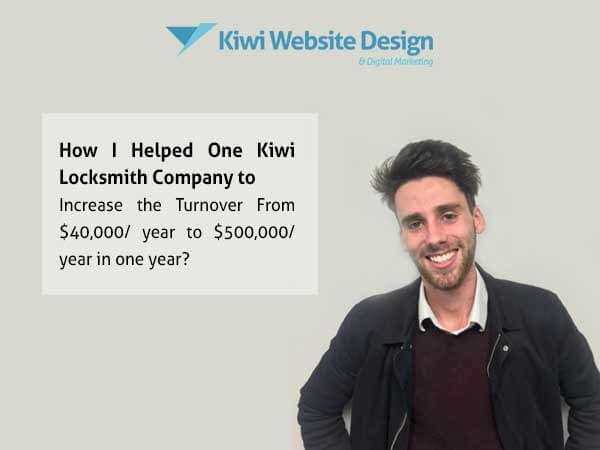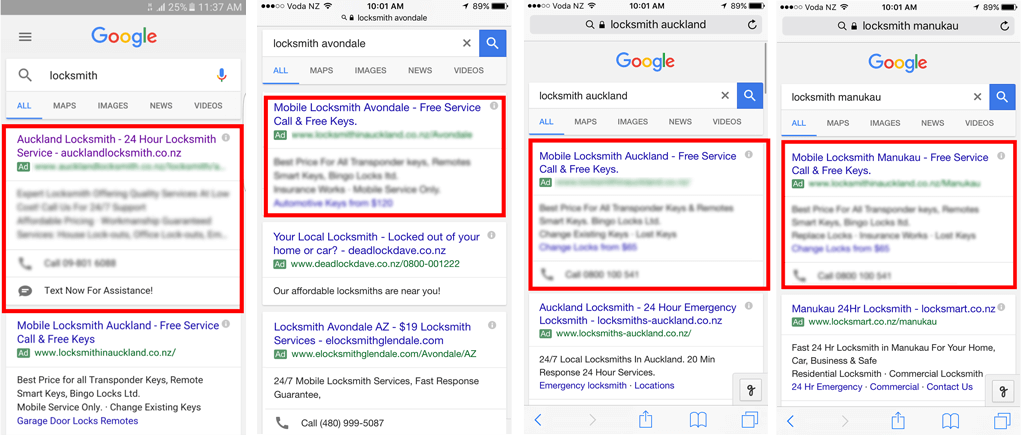How I Helped One Kiwi Locksmith Company Grow its Business and Increase its Turnover From $40,000 a Year to $500,000 a Year in One Year

Generating enough leads with Google AdWords seems like an uphill battle when keyword bid costs increase daily. For the majority of business owners, it is hard to imagine spending $1 per click, $2 per click, or more. What I have personally experienced is that, 10 years ago, these businesses would happily spend more than $1,000 for half-page ads in local newspapers and the Yellow Pages. By advertising in these publications, there was no way of measuring conversions or seeing what was working and what wasn’t working. However, with digital marketing today, we can see exact user behaviour and what keywords generate more leads and more business. We can even re-target people who visit your website but do not place an enquiry.
Being a Certified Google Partner, I have seen many businesses grow substantially by advertising on Google. At the same time, I have seen even more businesses miss great opportunities because of unknown fears. Some of the most common fears which prevent people from making this big decision are:
- What if my competitors click on my ads and waste my money?
- What if I don’t get a return on my investment?
- What if Google AdWords is rocket science and I just lose my money?
It is simply not possible for your competitors to eat your whole budget by clicking on your ads. Google has already thought of this problem and it considers them as invalid clicks so they don’t count against your ad spend. Secondly, even though Google has made using AdWords simple enough that anyone can set up an AdWords account, to make campaigns effective and get a good return on investment, you must dig very deep into the system. It actually is a science. To rank your ad in the top spots, it is important to consider and work on all Google AdWords’ ranking factors.
Why Google is Google?
Why do you search on Google? Why not Yahoo? Or why not Bing or any other search engine? You use Google because it gives you the most accurate search results.
For example, you are a mobile locksmith company based in Manukau. You want people to see your ad when they search for a locksmith anywhere in the Auckland region. Now, if someone is sitting in Albany, Northshore and searches for a locksmith company, Google automatically shows locksmiths that are near to Albany. Does this mean that a Manuka-based mobile locksmith company can’t do jobs in Albany? They obviously would love to do jobs in Albany as well, but the main challenge is that people in Albany will not see their ads because Google thinks the ads are not relevant because they are based in Manukau. To understand this better, let’s dig a bit deeper into it.
CTR (Click Through Rate)
Google only makes money when people click on ads. When people do not click on ads, Google does not make any money. Now, if someone sitting in Albany looks for a locksmith company, Google’s job is to:
- Display the most accurate result because that’s what Google does
- Make sure that it displays ads which it thinks people will find interesting and will click on
- Not put ads it thinks are irrelevant in the top spots
In the above example, the process is as follows:
- The user is based in Albany
- He is looking for a locksmith company as he has immediate locksmith needs
- If Google displays the ad of a locksmith company based in Manukau, it is highly unlikely the user will click on it
- As a result, Google will only waste its real estate by displaying this ad
- So, Google would rather display ads which it thinks are more likely to get clicks from the user
How I helped one Kiwi locksmith company increase its turnover from $40,000 a year to $500,000 a year in one year
When a locksmith company came to me it had an old website and a poor AdWords campaign. It was generating $40,000 in revenue annually and was struggling to drive more leads.
The owners wanted to grow their business throughout Auckland and drive more leads that would convert into sales. As a result, the objective was not to just drive traffic but to focus on sales. In order to achieve this goal, I started with the following changes:
- I built a new website using the WordPress content management system, making the website responsive and easy to update.
- I designed 198 separate landing pages covering 198 suburbs of Auckland. These were for Google AdWords and were tailored to capture leads with easy to use call to action buttons. Each landing page was designed for a specific suburb of Auckland. For example:
- I customised a specific landing page for Manukau to its potential customers by writing relevant content.
- Each landing page was advertised for one suburb. I made sure it was only visible to that specific suburb by inserting negative keywords. In this way, the ad looked more fitting and appropriate. Hence, the ads got a high CTR for each landing page.
- I used creative taglines and text to make the ads stand out from all the other ads on the page.
- I manually bided for the ad to achieve the highest visibility with the minimum cost. This saved more than half of the advertising budget of the company.
After implementing everything above, I managed to get first place on Google’s search results pages. You can see in the below screenshots that the locksmith’s ads are at the top for all relevant keyword searches:

After collecting enough data from Google AdWords, I crafted a potential customer list for remarketing. For people who are not familiar with the term remarketing, it is a campaign designed to target an audience who have already visited your website but may not have placed an enquiry. After implementing these strategies, we produced the following results in the first month:
- 200% increase in total site traffic
- 566% increase in enquiries
Today, this locksmith company has increased its turnover from $40,000 a year to $500,000 a year in a period of just 12 months – and it is still growing. The company is now planning to sell franchises in Hamilton and other cities in New Zealand.


Comments are closed.